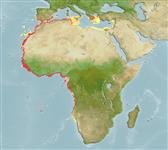>
Carangiformes (Jacks) >
Carangidae (Jacks and pompanos) > Caranginae
Etymology: Caranx: French, carangue, the name of a Caribbean fish; 1836 (Ref. 45335).
Environment: milieu / climate zone / depth range / distribution range
ນິເວດວິທະຍາ
ສັດທະເລ; ນ້ຳກ່ອຍ ກ່ຽວກັບ (ຢູ່)ເທິງຊັ້ນພື້ນດິນໃນທະເລເປີດ; ລະດັບຄວາມເລິກ 30 - 200 m (Ref. 27584), usually 30 - 50 m (Ref. 26999). Subtropical; 15°C - 22°C (Ref. 57055); 39°N - 22°S, 19°W - 36°E
Eastern Atlantic: Morocco to Angola (Ref. 4225, 57392), including the Mediterranean along the African coast. Range reported to extend south to Namibia (Ref. 27121).
Length at first maturity / ຂະໜາດ / ນ້ຳໜັກ / Age
Maturity: Lm ?, range 20 - ? cm
Max length : 60.0 cm TL ຕົວຜູ້/ບໍ່ມີເພດ; (Ref. 57392); common length : 35.0 cm TL ຕົວຜູ້/ບໍ່ມີເພດ; (Ref. 3397); ນ້ຳໜັກສູງສຸດທີ່ເຄຍຈັດພີມມາ: 1.0 kg (Ref. 27584)
ຄີ (ໜາມ)ແຂງຢູ່ຫຼັງປາ (ທັງໝົດ): 9; ຄີຫຼັງຂອງປາ (ຄີອ່ອນ) (ທັງໝົດ): 28-32; ຄີ(ໜາມ) ແຂງຢູ່ຄີກົ້ນປາ
ກຸ່ມປາກະດູກແຂງ
ຄວາມຖີ່ຂອງກຸ່ມຖ່າຍທອດພັນ
ປາທີ່ມີການເຄື່ອນຍ້າຍຈາກທະເລໄປຫານ້ຳຈືດ ແລະນ້ຳຈືດຫາທະເລ
ປາທີ່ມີການເຄື່ອນຍ້າຍຈາກທະເລແລະໄປໄຂ່ຢູ່ນ້ຳຈືດ
ຄີກົ້ນຂອງປາ
ສັດທີ່ມີກະດູກສັນຫັຼງ
ການຖ່າຍທອດທາງກຳມະພັນຈາກພໍ່ແມ່ຫາລູກ 3; ຄີກົ້ນຂອງປາ: 25 - 28. Diagnosis: body elongate and slightly compressed, its depth comprised from 3.8 to 4.4 times in fork length; eye posteriorly with a well developed adipose eyelid; 2 well separated dorsal fins, 1st with 8 spines, 2nd with 1 spine and 28-32 soft rays; anal fin with 2 detached spines, followed by 1 spine and 25-28 soft rays; last dorsal and anal ray transformed into a partially separate finlet, connected to the preceding ray by a low interradial membrane; pectoral fins short (comprised from 1.0 to 1.2 times in head length); scales small and cycloid; curved part of lateral line with 45-55 scales and 0-3 scutes, straight part with 0-8 scales and 24-32 scutes (Ref. 57392).
Coloration: back brownish to olivaceous, sides light olivaceous to whitish; a narrow yellowish band sometimes extending from head to caudal-fin base; a black spot on upper margin of gill cover; a black blotch with a narrow light distal margin present on second dorsal-fin lobe (Ref. 57392).
Form schools. They occur frequently near the bottom, mostly in depths of 30 to 50 m. Also pelagic and found near the surface at times. Entering brackish-water lagoons and estuaries (Ref. 57392). Feed on small fish and invertebrates (Ref. 3195). Spawning grounds are located in shallow waters (Ref. 57055). Eggs are pelagic (Ref. 4233).
A partial spawner (Ref. 57055).
Smith-Vaniz, W.F., J.-C. Quéro and M. Desoutter, 1990. Carangidae. p. 729-755. In J.C. Quero, J.C. Hureau, C. Karrer, A. Post and L. Saldanha (eds.) Check-list of the fishes of the eastern tropical Atlantic (CLOFETA). JNICT, Lisbon; SEI, Paris; and UNESCO, Paris. Vol. 2. (Ref. 7097)
IUCN Red List Status (Ref. 130435)
Threat to humans
Harmless
Human uses
ການປະມົງ: ເປັນສີນຄ້າ
ຂໍ້ມູນຕື່ມອີກ
ເອກະສານອ້າງອີງການລ້ຽງສັດນ້ຳຂໍ້ມູນການລ້ຽງສັດນ້ຳສາຍພັນກຳມະພັນElectrophoresesການຖ່າຍທອດທາງກຳມະພັນຈາກພໍ່ແມ່ຫາລູກພະຍາດການປຸງແຕ່ງNutrientsMass conversion
ເຄື່ອງມື
Special reports
Download XML
ແຫຼ່ງອີນເຕີເນັດ
Estimates based on models
Preferred temperature (Ref.
123201): 16.2 - 25.6, mean 19.2 °C (based on 58 cells).
Phylogenetic diversity index (Ref.
82804): PD
50 = 0.5000 [Uniqueness, from 0.5 = low to 2.0 = high].
Bayesian length-weight: a=0.01585 (0.01281 - 0.01961), b=2.94 (2.91 - 2.97), in cm total length, based on LWR estimates for this species (Ref.
93245).
ຊັ້ນເຂດຮ້ອນ (Ref.
69278): 3.6 ±0.59 se; based on food items.
Generation time: 6.9 ( na - na) years. Estimated as median ln(3)/K based on 2
growth studies.
ຄວາມຢືດຢຸ່ນ (Ref.
120179): ຂະໜາດກາງ, ປະຊາກອນຕຳ່ສຸດທີ່ໃຊ້ເວລາສອງເທົ່າ 1.4 - 4.4 ປີ (K=0.16-0.3; Fec = 480,000).
Prior r = 0.32, 95% CL = 0.21 - 0.48, Based on 1 stock assessment.
Fishing Vulnerability (Ref.
59153): Moderate vulnerability (36 of 100).
Climate Vulnerability (Ref.
125649): Low to moderate vulnerability (30 of 100).
Nutrients (Ref.
124155): Calcium = 30.7 [15.4, 66.6] mg/100g; Iron = 0.578 [0.312, 1.174] mg/100g; Protein = 19.1 [16.8, 21.6] %; Omega3 = 0.342 [0.178, 0.659] g/100g; Selenium = 38.9 [18.6, 89.4] μg/100g; VitaminA = 18.8 [6.4, 46.7] μg/100g; Zinc = 0.471 [0.325, 0.712] mg/100g (wet weight); based on
nutrient studies.
